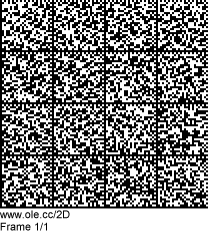INCA MoWriter 2-D barcode encoder & INCA MoReader 2-D barcode decoder
What is it
 INCA MoWriter encrypts data on printed paper by translating data into a 2-D barcode,
while INCA MoReader decrypts this specific barcode.
INCA MoWriter encrypts data on printed paper by translating data into a 2-D barcode,
while INCA MoReader decrypts this specific barcode.
Nobody can read this printed 2-D barcode, unless he has the INCA MoReader program and a key, you provide him. Consider the key as a pass-phrase.
Nobody can produce a meaningful 2-D barcode that will be read by INCA MoReader unless he has the specific required digital key, which means that nobody can feed the system with fake data.
In fact, since the translated data is just a 2-D barcode, a common 2-D scanner can read this data, but will read nothing more then meaningless sequences of characters and symbols. In order that this data translate back to the original content, a digital key (i.e. a pass-phrase) is required.
Offline: Limited data size, but big enough for your needs
Program can encrypt one or more document pages at once, because it can produce more than one barcode images, if required. The decoder will then scan all images and assemble them in the correct sequence, in order to reproduce the original data. In fact, encoder also compresses data, using the GZ algorithm. Up to 700 characters can be encoded in a single image.
Online: Virtually unlimited data size
If both computers on the encoder and decoder side, are supposed to connect to the internet, the program can virtually encode unlimited data size, since it actually prints the image of a digital signature and stores real data (encrypted) on a web server. Decoder then, automatically downloads the data.
Encoder can encode both text of any language (UTF-8) as well as binary data.
Normally, you would need a special scanner with specific language
support, to use the language of your choise, if other than English, i.e. Arab or Greek or Chinese.
But, using MoWriter and MoReader you do not need a special scanner with specific language
support.
Security
Data is sealed by a double security procedure.
Industry standard cryptography is first applied.
Inhouse developed algorithm is applied then.
Example
Edgar Allan Poe (January 19, 1809 October 7, 1849) was an
American writer, poet, editor and literary critic,
considered part of the American Romantic Movement. Best known
for his tales of mystery and the macabre, Poe was one of
the earliest American practitioners of the short story and is
considered the inventor of the detective-fiction genre. He
is further credited with contributing to the emerging genre
of science fiction.[1] He was the first well-known American
writer to try to earn a living through writing alone, resulting
in a financially difficult life and career.
Applications
- Proof of origin. Printed document holder can present the document to third party, perhaps public service, the bank, etc., and third party can verify proof of origin. Nobody can construct such a barcode, except autorized creator. The holder can only photocopy the document and thus remake an exact copy of the orginal, but can not make a new barcode with another content.
- Data encryption on a piece of paper. Barcode can contain supplementary data, not printed on paper in readable format. Holder of the document can not read the data, but only authorized reader can retrieve the encoded data.
- If both writer and reader are online (internet connected), virtually any size of data can be transferred on a small piece of paper.